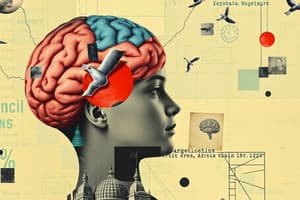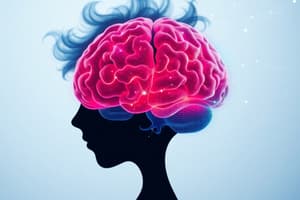Podcast
Questions and Answers
What behavioral change occurs in adolescents when they are aware that their friends are watching them play a game?
What behavioral change occurs in adolescents when they are aware that their friends are watching them play a game?
- They perform better under pressure.
- They crash more often. (correct)
- They make fewer risky choices.
- They feel less rewarded for their actions.
Which part of the brain shows increased activity in adolescents when friends are present?
Which part of the brain shows increased activity in adolescents when friends are present?
- Frontal cortex.
- Amygdala.
- Parietal lobe.
- Ventral striatum. (correct)
What key difference was observed between adolescents and adults in the experiment regarding behavior with peers?
What key difference was observed between adolescents and adults in the experiment regarding behavior with peers?
- Adolescents do not recognize risks associated with peer pressure.
- Adolescents behave similarly to adults when alone.
- Adults' behavior remains unchanged by peer presence. (correct)
- Adults are less risky in general.
What has been assumed to contribute to adolescents’ risky driving behavior in the presence of friends?
What has been assumed to contribute to adolescents’ risky driving behavior in the presence of friends?
How do adolescents' decision-making processes during potentially criminal situations differ from adults?
How do adolescents' decision-making processes during potentially criminal situations differ from adults?
What role does the inherent rewarding value of peers play for adolescents?
What role does the inherent rewarding value of peers play for adolescents?
Why do adolescents tend to commit more crimes in groups, according to the research discussed?
Why do adolescents tend to commit more crimes in groups, according to the research discussed?
What misconception does the study challenge regarding teen driving behavior?
What misconception does the study challenge regarding teen driving behavior?
What could be a potential implication of understanding adolescent behavior in relation to peers?
What could be a potential implication of understanding adolescent behavior in relation to peers?
What contributes to the observed increase in risky choices among adolescents in the presence of friends?
What contributes to the observed increase in risky choices among adolescents in the presence of friends?
What is a key factor that influences the brain's processing of experiences in adolescence?
What is a key factor that influences the brain's processing of experiences in adolescence?
How does risky behavior during adolescence contribute to development?
How does risky behavior during adolescence contribute to development?
What additional barriers may youths of color face regarding risk-taking?
What additional barriers may youths of color face regarding risk-taking?
What role does peer influence play in adolescent development?
What role does peer influence play in adolescent development?
Why is the ability to notice emotional cues important for adolescents?
Why is the ability to notice emotional cues important for adolescents?
What is essential to support adolescents’ growth?
What is essential to support adolescents’ growth?
How can adults promote positive peer influence among teenagers?
How can adults promote positive peer influence among teenagers?
What is a common misconception about adolescent judgment?
What is a common misconception about adolescent judgment?
Why is open communication with teenagers important?
Why is open communication with teenagers important?
What aspect of adolescent behavior is crucial for their development?
What aspect of adolescent behavior is crucial for their development?
Which neurotransmitter is linked to learning from unexpected rewards in teens?
Which neurotransmitter is linked to learning from unexpected rewards in teens?
What factor has a significant impact on social acceptance during adolescence?
What factor has a significant impact on social acceptance during adolescence?
What can be the outcome of negative peer pressure during adolescence?
What can be the outcome of negative peer pressure during adolescence?
What is a significant concern regarding teen risk-taking behaviors?
What is a significant concern regarding teen risk-taking behaviors?
Match the following aspects of adolescence with their descriptions:
Match the following aspects of adolescence with their descriptions:
Match the following challenges faced by adolescents with their implications:
Match the following challenges faced by adolescents with their implications:
Match the following social skills with their significance for adolescents:
Match the following social skills with their significance for adolescents:
Match the following environmental factors with their role in adolescent development:
Match the following environmental factors with their role in adolescent development:
Match these behavioral phenomena with their corresponding adolescent contexts:
Match these behavioral phenomena with their corresponding adolescent contexts:
Match the following developmental characteristics of adolescence with their outcomes:
Match the following developmental characteristics of adolescence with their outcomes:
Match the following terms related to adolescence with their definitions:
Match the following terms related to adolescence with their definitions:
Match the following concepts related to teenage brain function with their roles:
Match the following concepts related to teenage brain function with their roles:
Match the following statements about adolescence with their correct conclusions:
Match the following statements about adolescence with their correct conclusions:
Match the following types of peer influence with their examples:
Match the following types of peer influence with their examples:
Match the following terms with their corresponding descriptions:
Match the following terms with their corresponding descriptions:
Match the following behaviors with their relevant influences:
Match the following behaviors with their relevant influences:
Match the following effects with their outcomes:
Match the following effects with their outcomes:
Match the following situations with their corresponding outcomes:
Match the following situations with their corresponding outcomes:
Match the following key terms with their consequences:
Match the following key terms with their consequences:
Match the following observations with their related factors:
Match the following observations with their related factors:
Match the following implications with their contexts:
Match the following implications with their contexts:
Match the following findings with their significance:
Match the following findings with their significance:
Match the following areas of interest with their potential research implications:
Match the following areas of interest with their potential research implications:
Flashcards are hidden until you start studying
Study Notes
Adolescence and Risk-Taking
- Adolescence is a period of significant brain development, marked by an increased willingness to engage with uncertainty, especially when there is potential for reward.
- This openness to uncertainty is crucial for adolescent learning and development, and risk-taking is an essential part of this process.
- Adolescence face numerous challenges such as shifting social dynamics, increased responsibilities, and tougher schoolwork, all of which contribute to an environment filled with uncertainty.
- Dopamine plays a key role in how the brain processes these experiences, driving both feelings of pleasure and learning.
- When adolescents receive unexpected rewards, dopamine levels spike, prompting the brain to pay attention and strengthening connections between different brain regions, facilitating learning and memory.
Peer Influence and Social Dynamics
- During adolescence, the brain becomes highly attuned to social acceptance and rejection, making teenagers very sensitive to peer opinions and feelings.
- Peer influence can be a powerful force in adolescent decision-making and behavior, impacting both positively and negatively.
- Adolescents are particularly adept at reading emotional cues such as facial expressions and body language, a skill essential for navigating social situations and building strong relationships.
- The desire to fit in can lead adolescents to adopt behaviors and attitudes prevalent within their peer group, which can sometimes lead to negative peer pressure.
- Parents and educators should openly discuss peer pressure with teenagers and guide them in making healthy, independent choices.
The Brain's Response to Social Context
- Studies using the "Stoplight Game" demonstrate that adolescents are more likely to take risks when they believe their friends are watching them.
- This heightened risk-taking behavior is associated with increased activity in the ventral striatum, a brain region associated with reward processing.
- Adults do not exhibit the same increase in risk-taking behavior or brain activity when their friends are present.
- This suggests that during adolescence, the presence of peers activates the brain's reward circuitry, making them more likely to prioritize potential rewards over potential downsides.
- This finding has implications for understanding adolescent criminal behavior, as adolescents are more likely to engage in criminal activities when they are in groups.
- The increased reward sensitivity brought on by peer presence may contribute to poor judgment and decision-making in potentially criminal situations during adolescence.
Risk-Taking in Adolescence
- Adolescents are more inclined to engage in uncertain situations, especially if there's a potential reward.
- This openness to uncertainty is vital for their learning and development.
- Risk-taking during adolescence facilitates personal discovery, skill development, and preparation for adulthood.
- Dopamine plays a key role in how adolescents experience uncertainty and reward.
- Dopamine levels spike when adolescents experience unexpected rewards, leading to increased brain activity and connections, which in turn improves learning and memory.
- The adolescent brain is highly adaptable and responds well to novel experiences.
- Supportive environments are crucial for adolescents to build relationships, exercise independence, and take risks.
- Providing safe spaces for exploration is essential for healthy development.
Social Influence and Peer Pressure
- Adolescent brains become more sensitive to social acceptance and rejection.
- Peer influence is strong during adolescence, impacting decisions and behaviors.
- This influence can motivate positive activities and choices.
- Adolescents are adept at understanding emotional cues like facial expressions and body language, aiding social interactions and building empathy.
- The desire to fit in can lead to conforming to peer behavior, both positive and negative.
- Open communication between adults and adolescents is crucial for navigating peer pressure and making healthy choices.
- Supportive school and community environments that foster inclusivity and teamwork are essential for healthy development.
The Brain's Response to Peer Influence
- Adolescents have stronger brain responses when engaging in risky behavior when peers are present, even just in thought.
- There is no distinction between adult behavior in the presence or absence of friends.
- The presence of peers activates the brain’s reward circuitry in adolescents, making them more focused on potential rewards and less attuned to potential consequences.
- The research suggests a link between the impact of peer influence on reward sensitivity and adolescent criminal behavior.
- This suggests that peer influence can potentially play a role in adolescent judgment and decision-making in risky situations, including those involving criminal behavior.
Studying That Suits You
Use AI to generate personalized quizzes and flashcards to suit your learning preferences.




